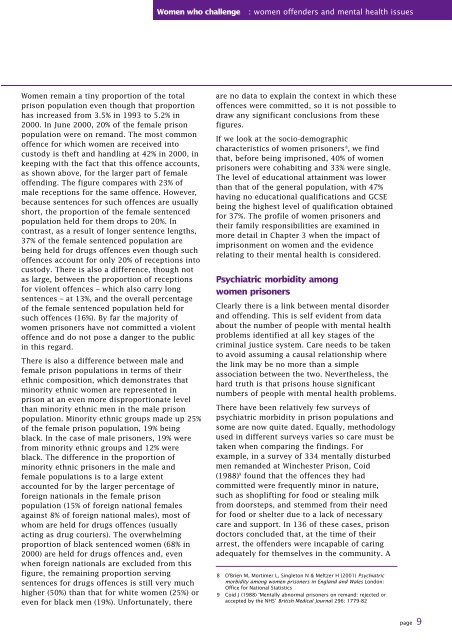Women who challenge - Nacro
Women who challenge - Nacro
Women who challenge - Nacro
- No tags were found...
Create successful ePaper yourself
Turn your PDF publications into a flip-book with our unique Google optimized e-Paper software.
<strong>Women</strong> <strong>who</strong> <strong>challenge</strong>: women offenders and mental health issues<strong>Women</strong> remain a tiny proportion of the totalprison population even though that proportionhas increased from 3.5% in 1993 to 5.2% in2000. In June 2000, 20% of the female prisonpopulation were on remand. The most commonoffence for which women are received intocustody is theft and handling at 42% in 2000, inkeeping with the fact that this offence accounts,as shown above, for the larger part of femaleoffending. The figure compares with 23% ofmale receptions for the same offence. However,because sentences for such offences are usuallyshort, the proportion of the female sentencedpopulation held for them drops to 20%. Incontrast, as a result of longer sentence lengths,37% of the female sentenced population arebeing held for drugs offences even though suchoffences account for only 20% of receptions intocustody. There is also a difference, though notas large, between the proportion of receptionsfor violent offences – which also carry longsentences – at 13%, and the overall percentageof the female sentenced population held forsuch offences (16%). By far the majority ofwomen prisoners have not committed a violentoffence and do not pose a danger to the publicin this regard.There is also a difference between male andfemale prison populations in terms of theirethnic composition, which demonstrates thatminority ethnic women are represented inprison at an even more disproportionate levelthan minority ethnic men in the male prisonpopulation. Minority ethnic groups made up 25%of the female prison population, 19% beingblack. In the case of male prisoners, 19% werefrom minority ethnic groups and 12% wereblack. The difference in the proportion ofminority ethnic prisoners in the male andfemale populations is to a large extentaccounted for by the larger percentage offoreign nationals in the female prisonpopulation (15% of foreign national femalesagainst 8% of foreign national males), most of<strong>who</strong>m are held for drugs offences (usuallyacting as drug couriers). The overwhelmingproportion of black sentenced women (68% in2000) are held for drugs offences and, evenwhen foreign nationals are excluded from thisfigure, the remaining proportion servingsentences for drugs offences is still very muchhigher (50%) than that for white women (25%) oreven for black men (19%). Unfortunately, thereare no data to explain the context in which theseoffences were committed, so it is not possible todraw any significant conclusions from thesefigures.If we look at the socio-demographiccharacteristics of women prisoners 8 , we findthat, before being imprisoned, 40% of womenprisoners were cohabiting and 33% were single.The level of educational attainment was lowerthan that of the general population, with 47%having no educational qualifications and GCSEbeing the highest level of qualification obtainedfor 37%. The profile of women prisoners andtheir family responsibilities are examined inmore detail in Chapter 3 when the impact ofimprisonment on women and the evidencerelating to their mental health is considered.Psychiatric morbidity amongwomen prisonersClearly there is a link between mental disorderand offending. This is self evident from dataabout the number of people with mental healthproblems identified at all key stages of thecriminal justice system. Care needs to be takento avoid assuming a causal relationship wherethe link may be no more than a simpleassociation between the two. Nevertheless, thehard truth is that prisons house significantnumbers of people with mental health problems.There have been relatively few surveys ofpsychiatric morbidity in prison populations andsome are now quite dated. Equally, methodologyused in different surveys varies so care must betaken when comparing the findings. Forexample, in a survey of 334 mentally disturbedmen remanded at Winchester Prison, Coid(1988) 9 found that the offences they hadcommitted were frequently minor in nature,such as shoplifting for food or stealing milkfrom doorsteps, and stemmed from their needfor food or shelter due to a lack of necessarycare and support. In 136 of these cases, prisondoctors concluded that, at the time of theirarrest, the offenders were incapable of caringadequately for themselves in the community. A8 O’Brien M, Mortimer L, Singleton N & Meltzer H (2001) Psychiatricmorbidity among women prisoners in England and Wales London:Office for National Statistics9 Coid J (1988) ‘Mentally abnormal prisoners on remand: rejected oraccepted by the NHS’ British Medical Journal 296: 1779-82page 9
















